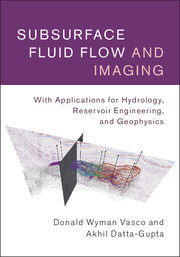 Subsurface Fluid Flow and Imaging
Subsurface Fluid Flow and Imaging Book contents
- Frontmatter
- Contents
- Preface
- Acknowledgments
- 1 The propagation of a disturbance in relation to imaging
- 2 Principles and equations governing fluid flow and deformation
- 3 Trajectory-based modeling
- 4 Equations in diffusion form
- 5 Equations governing advection and transport
- 6 Immiscible fluid flow
- 7 Coupled deformation and fluid flow
- 8 Appendix: a guide to the accompanying software
- References
- Index
- Colour plate section between pages 150 and 151
4 - Equations in diffusion form
Published online by Cambridge University Press: 05 July 2016
- Frontmatter
- Contents
- Preface
- Acknowledgments
- 1 The propagation of a disturbance in relation to imaging
- 2 Principles and equations governing fluid flow and deformation
- 3 Trajectory-based modeling
- 4 Equations in diffusion form
- 5 Equations governing advection and transport
- 6 Immiscible fluid flow
- 7 Coupled deformation and fluid flow
- 8 Appendix: a guide to the accompanying software
- References
- Index
- Colour plate section between pages 150 and 151
Summary
Introduction
Diffusive processes are often assumed to have very little in common with solutions of the hyperbolic partial differential equations governing wave-like propagation. Indeed, solutions of the diffusion equation decay in an exponential fashion with distance from the source of a disturbance. Thus, to propagate an observable disturbance away from a source it is often necessary to continuously supply mass or energy. For example, in order to propagate an observable pressure disturbance from an injection point to a distant location it is typically necessary to introduce fluid at a constant rate into the porous medium for a sustained period of time. However, as indicated in Chapter 1, transient solutions to the diffusion equation do indeed propagate, and, as will be shown in this chapter, one may derive an expression governing the phase of such a propagating disturbance. The governing equation for the phase is a Hamilton–Jacobi equation, identical in form to the eikonal equation encountered earlier. However, the interpretation and the effect of the phase function is significantly different from that of a propagating wave, in keeping with the very different nature of diffusion. In this chapter we shall consider one approach for developing a trajectory-based solution for diffusion equation, a high-frequency asymptotic expansion. We shall illustrate the approach and its utility with a few applications, including diffusion tomography.
A high-frequency asymptotic solution
Here we derive a high-frequency asymptotic solution for the diffusion equation. The phrase ‘high-frequency’ is not commonly associated with diffusive processes. However, a high-frequency component is present in the early rapid variations of pressure due to the onset of fluid injection. Also, the notion of what constitutes a high frequency is relative to the temporal variation of the background field, which can be gradual. Admittedly, the approximation does not have the long reach associated with processes such as elastic wave propagation and is often restricted to a region surrounding the source. Still, the range over which we can utilize a transient pressure disturbance is far enough to provide a powerful tool for imaging flow properties between a given source and receiver. Furthermore, our asymptotic analysis allows us to draw a connection between the well developed modeling of wave propagation and transient solutions to the diffusion equation. Such a connection is useful in understanding coupled processes and equations of a mixed nature: those that are neither entirely wave-like nor completely diffusive in character.
Information
- Type
- Chapter
- Information
- Subsurface Fluid Flow and ImagingWith Applications for Hydrology, Reservoir Engineering, and Geophysics, pp. 131 - 171Publisher: Cambridge University PressPrint publication year: 2016